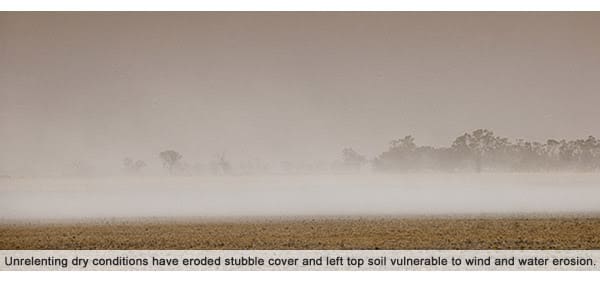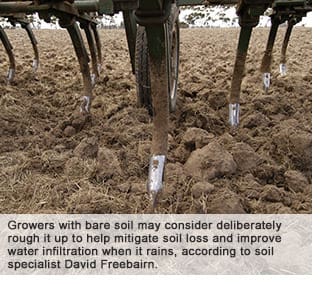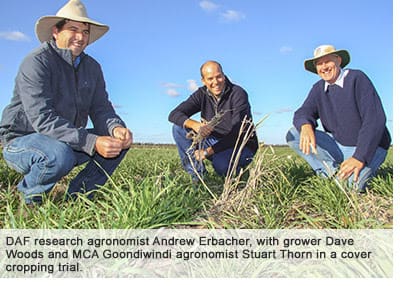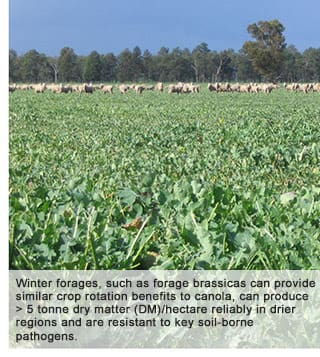
FOR those growers in the drought-affected areas who have missed out on recent storm rains, ground cover or the lack of it remains a primary concern.
Unrelenting dry conditions have eroded stubble cover levels across the farming regions of northern New South Wales and Queensland leaving many growers questioning how to best-protect their precious topsoil from the devastating effects of wind and water erosion.
Wind erosion is not generally an issue in northern cropping areas with many located in medium rainfall zones and characterised by well-structured clays.
However, growers have been facing significant management challenges in recent years, dramatically revising or completely halting cropping programs due to a lack of rainfall which has left some paddocks exposed and vulnerable to topsoil loss and erosion.
Serious deficiencies in the soil moisture profile mean soil management options are limited, but in certain situations there may be opportunities to consider: tillage, a cover crop or a forage crop.
Is tillage an option?
University of Southern Queensland associate professor Dr David Freebairn, who has been involved in soil management research for more than 40 years, said there was a practical option available to growers who found themselves in low groundcover situations.
 “There’s certainly no black and white answers and the options are limited, but there are options nonetheless,” Dr Freebairn said.
“There’s certainly no black and white answers and the options are limited, but there are options nonetheless,” Dr Freebairn said.
“If growers have bare soil and it’s been armoured by small falls of rain, a deliberately rough cultivation such as a chisel tillage isn’t a bad idea. We know that a bare and uncultivated soil is the hardest condition to get rainfall into the soil.
“In the current conditions, roughness is really the only management option left for those with bare ground to help mitigate soil loss and improve water infiltration when it eventually does rain.
“However, it’s important to note that the advice is very different in situations where the soil is cracked and open – in these instances soil should always be left alone, at least until cracks close with stored water.”
Research investments by the Grains Research and Development Corporation (GRDC) into the impact of tillage in south eastern Australia have shown that any soil damage is relatively small and short term.
Protection with cover crops
Another option that may be available to some growers depending on how and when rain falls, is the sowing of a cover crop.
Cover crops are not new; they have been predominantly used by organic and low-input growers to protect the soil from erosion in low stubble situations, return biomass that helps maintain soil organic matter and biological activity, and to provide additional nitrogen when legumes are used.
Cover crop research conducted by the Department of Agriculture and Fisheries (DAF) under a joint GRDC and Cotton Research and Development Corporation investment has shown that cover crops can provide benefits with little or no net loss of soil water at the end of the fallow period even in drier-than-normal seasons.
However, growing cover crops still requires water and in the northern region where every 10mm of extra stored soil water available to crops can increase grain yields by 150kg/hectare, planting crops that don’t produce grain could be considered `wasteful’ of precious water reserves.
Nevertheless, given the recent seasonal conditions cover crops may be a viable alternative to leaving paddocks bare in certain situations.
While most growers will obviously have their hopes pinned on receiving sufficient rain to plant wheat to provide stubble cover going forward, available soil moisture will ultimately govern decision making and it’s likely most areas would require at least 90mm of plant available water (PAW) at planting to achieve reasonable wheat yields.
Other considerations when weighing up the cover crop option are:
- What proportion of the farm needs more cover – are there some paddocks with reasonable stubble that could be long fallowed for break crops or seasonal/crop risk management or could cover crops be used in some area to maintain a cropping phase split?
- The paddock’s cropping history and therefore the implications for disease risk – although risk from diseases such as crown rot may be lower if stubble is lacking.
- Arbuscular mycorrhizal fungi (AMF – previously known as vesicular arbuscular mycorrhizal or VAM fungi) could be low on long fallow country which could affect a crop’s ability to access nutrients such as phosphorous (P) and zinc (Zn). Growing a less AMF reliant species either as a cover crop or cash crop should be considered before growing a more AMF reliant crop such as cotton. AMF levels can be assessed using PREDICTA® B testing.
- Even plant density in establishment is the main difference between an effective cover crop (for improved fallow PAW storage) and a weedy paddock (that reduces water and nitrogen availability for the next crop).
- Stored seed can be a viable, lower cost option for establishing cover crops, providing good population is established. A germination test can be quickly and easily done on site. If planting into marginal conditions or deeper, vigour becomes important which may require lab testing. In these instances, forward planning is critical – it is too late to test once the planter starts rolling.
- Beware of the temptation to harvest silo seed (especially hybrid, or mixed varieties) if the season goes with you.
According to Queensland Department of Agriculture and Fisheries (DAF) research agronomist Andrew Erbacher, the best crop species will depend on the time of year, production environment and moisture conditions at planting.
 “For example, millet needs shallow planting which is risky in marginal moisture and/or hot conditions with a fast drying surface; sorghum will allow deeper planting; and later in the year winter species may provide faster establishment,” he said.
“For example, millet needs shallow planting which is risky in marginal moisture and/or hot conditions with a fast drying surface; sorghum will allow deeper planting; and later in the year winter species may provide faster establishment,” he said.
“Our research assessed cereal, cereal/legume and tillage radish cover crops and within that scope, cereals were found to provide the best resilient stubble for fallow water accumulation.
“If planting a cover crop is an option, I would suggest looking at what is going to establish best and develop to the termination growth stage quickest, although this could be high risk if the temptation kicks in to harvest a winter cover crop.”
Mr Erbacher said having a spray-out strategy at the outset with the next crop in mind was important and would be dictated by proceeding fallow length and cover crop species/variety.
“Our research targeted flag leaf emergence as mid termination. Slightly earlier can work for a short fallow (ie. 2-4 months), delaying up to anthesis will provide more resilient stubble albeit with a with a water cost, but delaying further into grain fill has a greater water cost without the stubble improvements,” he said.
“Leaving spray-out too long can cost a lot of water – an unreplicated strip in one of our trials measured an extra 60mm water use for a two week delay in terminating the large French millet cover-crop.
“However, terminating the cover-crop too early with leafy stubble can accelerate breakdown and see the paddock run out of cover before the end of the fallow.”
Forage crops
For mixed farming enterprises, forage crops may also be a consideration in marginal moisture situations, given they don’t require moisture at the end of the crop cycle for grain fill.
Depending on growing conditions, timing and extent of rainfall and PAW, there are a number of forage crop options.
 Winter forages, such as forage brassicas can provide similar crop rotation benefits to canola, can produce > 5 tonne dry matter (DM)/hectare reliably in drier regions and are resistant to key soil-borne pathogens.
Winter forages, such as forage brassicas can provide similar crop rotation benefits to canola, can produce > 5 tonne dry matter (DM)/hectare reliably in drier regions and are resistant to key soil-borne pathogens.
Several field pea varieties could provide flexible dual-purpose options which can produce forage yields of up to 80 per cent in oats, provide nitrogen inputs and offer weed management and crop rotation benefits.
Summer forage options such as millet, sorghum and legumes like lablab can be used to transition between summer and winter crop phases and provide disease and weed management benefits, while summer and winter annual and short-lived perennial legumes, such as burgundy bean or vetch, can also provide break crop benefits along with fixing atmospheric nitrogen for subsequent crops.
Before opting to plant a forage crop however, it is important that growers have a clear understanding of the paddock’s residual herbicide history and any risks to animal health from the forage species; ensure seed is appropriately inoculated, apply phosphorus and sulphur at sowing, and pay particular attention to sowing depth to optimise establishment.
Source: GRDC
Grain Central: Get our free daily cropping news straight to your inbox – Click here

Helianthus Tuberosus can be grown in alkaline or saline soils . This crop has recently been added to Agriculture Canada’s Registered Feed List. USA Feedipedia also as well . Perennial growth and has been studied in Aus. Considered nutritious as Alfalfa . Visit novagreen.ca to view the various markets that will be will be available to producers of this crop. Fructose sugar to nonGMO bioplastics and jet fuel and Carbon skins . GMO free Sugarcane can be marketed to serve a demanding markets and saline water bores be productive for growing JA to extract other of the various succinic acid and Soluble Fibre Inulin, now in high demand worldwide. LW